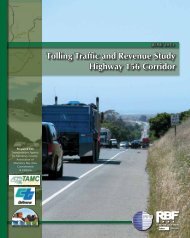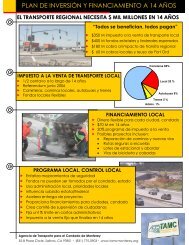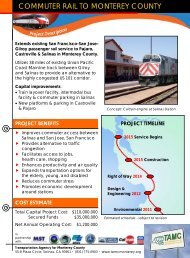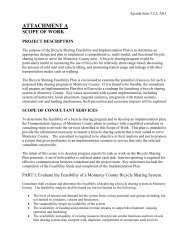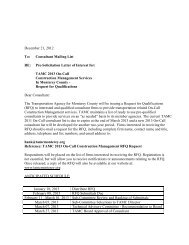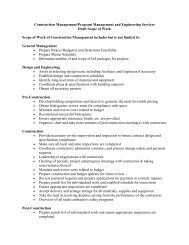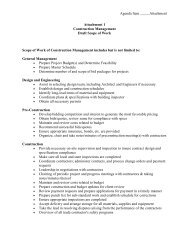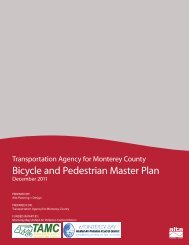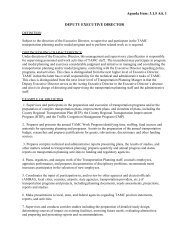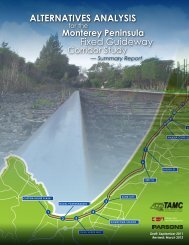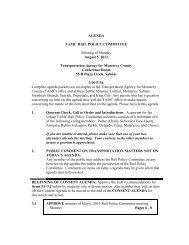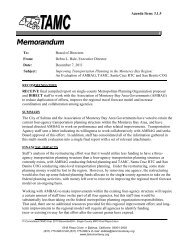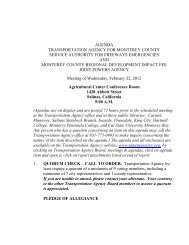Commuter Rail Extension Alternatives Analysis - Transportation ...
Commuter Rail Extension Alternatives Analysis - Transportation ...
Commuter Rail Extension Alternatives Analysis - Transportation ...
Create successful ePaper yourself
Turn your PDF publications into a flip-book with our unique Google optimized e-Paper software.
CALTRAIN EXTENSION TO MONTEREY COUNTYALTERNATIVES ANALYSISTable 8-3Total Travel Times (minutes) for Auto/Caltrain/Express Bus JourneysOrigin StationDestination Station Pajaro Castroville Salinas2010San Jose (Santa Clara–Mid) 79/120/120 81/136/136 84/147/147Mountain View (Santa Clara–North) 126/146/146 128/162/162 131/173/1732030San Jose (Santa Clara–Mid) 91/120/132 99/136/152 104/147/165Mountain View (Santa Clara–North) 158/146/160 166/162/180 171/173/193Automobile travel times (includes 10 minutes of terminal time)Caltrain travel times (includes out-of-vehicle time weighted × 2.0)Express bus travel times (includes out-of-vehicle time weighted × 2.0)Source: ParsonsBy comparison, traveling by Caltrain or express bus will free the commuter to read, work, write and/orrelax. This recovered time can be viewed to be a travel time “savings.”For the purpose of this benefit calculation, travel time savings, i.e., time which can be put toproductive use, is computed to be time on-board the line haul transit vehicle (Caltrain or express bus),minus the time difference of the overall journey by transit versus automobile (Method 1).Figure 8-1 illustrates this travel time savings concept. Table 8-4 reports the findings of this analysis.An alternative and more conservative approach to calculating travel time savings (Method 2) is tobase the savings on the total travel time difference between the highway and transit for the Caltrain<strong>Extension</strong> project scenario. The Cal-B/C 1 utilizes this approach.“ If the difference in travel time is negative (i.e., the travel time is smaller on the parallel highwaythan on transit), the benefit is assumed to be zero. The new transit riders must have shiftedmodels for reasons other than travel time savings. Assuming that these new riders are rationalin their decision making, the sum of these benefits must be positive. Since Cal-B/C is unlikelyto capture all of the benefits (e.g., the value of reducing one’s stress by not having to drive, theimproved reliability of transit, etc.), the model conservatively estimates that the new transitriders do not receive a benefit.”A third approach (Method 3) is to recognize some useful benefit to the on-board line haul portion ofthe transit trip. This method weighs the in-vehicle travel time by a factor, typically 75 percent, andthen calculates the total travel time difference. Table 8-5 reports the findings of this analysis.Value of TimeConsistent with U.S. Department of <strong>Transportation</strong> guidance for the valuation of travel time ineconomic analysis, local personal travel was assumed to be valued at 50 percent of the local medianwage rate. Monterey County’s mean wage for all occupations was reported by the CaliforniaEmployment Development Department to be $18.01 per hour for the third quarter of 2005, or $37,458when expressed as an annual wage or salary. Using this wage rate as a basis, the value of timewould equal $9.00 per hour.Most people who commute to Silicon Valley (Santa Clara County) do so to earn a higher wage,however. Why else would a worker commute 60 to 100 miles from home to work to earn the samewage found locally.1Technical Supplement to User’s Guide, Booz • Allen & Hamilton, Inc., September 1999.parsons CHAPTER 8: EVALUATION OF ALTERNATIVES 179



